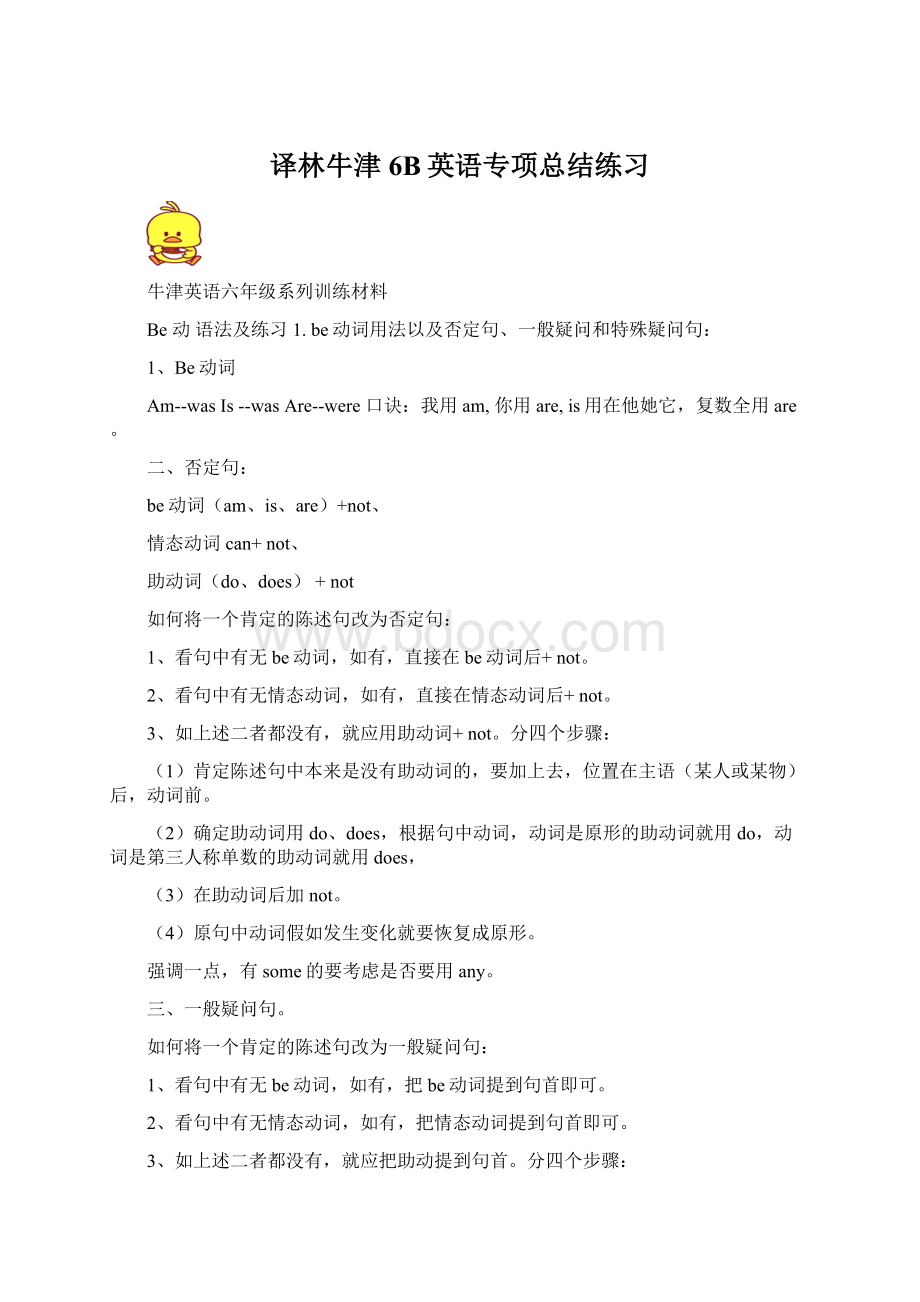译林牛津6B英语专项总结练习.docx
《译林牛津6B英语专项总结练习.docx》由会员分享,可在线阅读,更多相关《译林牛津6B英语专项总结练习.docx(22页珍藏版)》请在冰豆网上搜索。

译林牛津6B英语专项总结练习
牛津英语六年级系列训练材料
Be动语法及练习1.be动词用法以及否定句、一般疑问和特殊疑问句:
1、Be动词
Am--wasIs--wasAre--were口诀:
我用am,你用are,is用在他她它,复数全用are。
二、否定句:
be动词(am、is、are)+not、
情态动词can+not、
助动词(do、does)+not
如何将一个肯定的陈述句改为否定句:
1、看句中有无be动词,如有,直接在be动词后+not。
2、看句中有无情态动词,如有,直接在情态动词后+not。
3、如上述二者都没有,就应用助动词+not。
分四个步骤:
(1)肯定陈述句中本来是没有助动词的,要加上去,位置在主语(某人或某物)后,动词前。
(2)确定助动词用do、does,根据句中动词,动词是原形的助动词就用do,动词是第三人称单数的助动词就用does,
(3)在助动词后加not。
(4)原句中动词假如发生变化就要恢复成原形。
强调一点,有some的要考虑是否要用any。
三、一般疑问句。
如何将一个肯定的陈述句改为一般疑问句:
1、看句中有无be动词,如有,把be动词提到句首即可。
2、看句中有无情态动词,如有,把情态动词提到句首即可。
3、如上述二者都没有,就应把助动提到句首。
分四个步骤:
(1)肯定陈述句中本来是没有助动词的,要加上去,位置在主语(某人或某物)后,动词前。
(2)确定助动词用do还是does,根据句中动词,动词是原形的助动词就用do,动词是第三人称单数的助动词就用does
(3)把助动词后提到句首。
(4)原句中动词假如发生变化就要恢复成原形。
强调一点,有some的要考虑是否要用any。
四、特殊疑问句。
表示疑问,有疑问词(在开头),回答有很多种可能。
常用疑问词:
疑问词
意思
用法
Whattime
什么时间
问具体时间,如几点钟
Who
谁
问人
Whose
谁的
问主人
Where
在哪里
问地点
What
什么
问东西、事物
Whatcolour
什么颜色
问颜色
Howold
多大年纪
问年纪
Howmany
多少数量(可数名词)
问数量
Howmuch
多少钱;多少数量(不可数名词)
问多少钱或数量(不可数)
用恰当的be动词填空。
1.I______aboy.______youaboy?
No,I_____not.
2.Thegirl______Jack'ssister.
3.Thedog_______tallandfat.
4.Themanwithbigeyes_______ateacher.
5.______yourbrotherintheclassroom?
6.Where_____yourmother?
She______athome.
7.How_______yourfather?
8.MikeandLiuTao______atschool.
9.Whosedress______this?
10.Whosesocks______they?
11.That______myredskirt.
12.Who______I?
13.Thejeans______onthedesk.
14.Here______ascarfforyou.
15.Here______somesweatersforyou.
16.Theblackgloves______forSuYang.
17.Thispairofgloves______forYangLing.
18.Thetwocupsofmilk_____forme.
19.Sometea______intheglass.
20.Gaoshan'sshirt_______overthere.
21.Mysister'sname______Nancy.
22.This______notWangFang'spencil.
23.______DavidandHelenfromEngland?
24.There______agirlintheroom.
25.There______someapplesonthetree.
26._______thereanykitesintheclassroom?
27._______thereanyapplejuiceinthebottle?
28.There_______somebreadontheplate.
语法及练习2人称代词和物主代词
人称代词和物主代词
1.人称代词主格和宾格的区别:
主格通常位于句中第一个动词之前(有时候位于than之后),宾格一般位于动词或介词之后。
2.物主代词形容词性与名词性的区别:
形容词性用时后面一般要带上名词,名词性则单独使用,后面不带名词。
3、人称代词和物主代词
人称代词
物主代词
单数
复数
单数
复数
主格
宾格
主格
宾格
形容词性
形容词性
第一人称
I(我)
me
we(我们)
us
my(我的)
our(我们的)
第二人称
you(你)
you
you(你们)
you
your(你的)
your(你们的)
第三人称
he(他)
him
they
(他/她/它们)
them
his(他的)
their
(他/她/它们的)
she(她)
her
her(她的)
it(它)
it
it(它的)
人称代词:
有主格和宾格之分。
一般动词前用主格,动词后用宾格。
4、指示代词
指近处
指远处
单数
this(这个)
that(那个)
复数
these(这些)
those(那些)
5、冠词
有a、an、the。
a和an的区别:
an用于元音音素(一般就是元音字母a、e、i、o、u)前,a用于辅音音素.
a
E.g.a"u",ausualmeeting,aone-wayticket
an
E.g.anhour;anhonestboy;an"m";anuncle
一.填写代词表主格。
I
it
we
you
them
his
your
hers
二.用所给词的适当形式填空。
1.Thatisnot_________kite.Thatkiteisverysmall,but_________isverybig.(I)
2.Thedressis_________.Giveitto_________.(she)
3.Isthis_________watch?
(you)No,it’snot_________.(I)
4._________ismybrother.________nameisJack.Look!
Thosestampsare_________.(he)
5._________dressesarered.(we)Whatcolourare_________?
(you)
6.Herearemanydolls,whichoneis_________?
(she)
7.Icanfindmytoy,butwhere’s_________?
(you)
8.Show_________yourkite,OK?
(they)
9.Ihaveabeautifulcat._________nameisMimi.Thesecakesare_________.(it)
10.Arethese________tickets?
No,________arenot_________.________aren’there.(they)11.Shall_________havealookatthatclassroom?
Thatis_________classroom.(we)
12._________ismyaunt.Doyouknow_________job?
_________anurse.(she)
13.Thatisnot_________camera._________isathome.(he)
14.Whereare_________?
Ican’tfind_________.Let’scall_________parents.(they)
15.Don’ttouch_________._________notacat,_________atiger!
16._________sisterisill.Pleasegoandget_________.(she)
17._________don’tknowhername.Wouldyoupleasetell_________.(we)
18.Somanydogs.Let’scount_________.(they)
19.Ihavealovelybrother._________isonly3.Ilike_________verymuch.(he)
20.MayIsitbeside_________?
(you)
21.Lookatthatdesk.Thosebookareon_________.(it)
22.Thegirlbehind_________isourfriend.(she)
语法及练习3名词复数和动词三单
一、名词复数规则
1.一般情况下,直接加-s,如:
book-books,bag-bags,cat-cats,bed-beds
2.以s.x.sh.ch结尾,加-es,如:
bus-buses,box-boxes,brush-brushes,watch-watches,class-classes,glass-glasses,
3.1).以“辅音字母+y”结尾,变y为i,再加-es,如:
family-families,city-cities,baby-babies,county-counties.
2).”y”前面是元音的话,在”y”后直接加”s”,如:
play-playsway-waysvalley-valleysdonkey-donkeys,toy-toys,boy-boys,guy-guys
4.以“f或fe”结尾,变f或fe为v,再加-es,如:
knife-knives,half-halves,myself-ourselves,yourself-yourselves,leaf-leaves,life-lives,wolf-wolves,wife-wives,shelf-shelves,thief-thieves
5.以”o”结尾的单词,一般情况加”es”,如:
tomatoes,potatoes,但photo除外:
photos
6.不规则名词复数:
man-men,woman-women,policeman-policemen,policewoman-policewomen,mouse-micechild-childrenfoot-feet,.tooth-teeth
7.单复数同行:
sheep-sheep,deer-deer,fish-fish,people-people,Chinese-Chinese,Japanese-Japanese
练习:
写出下列各词的复数。
I_________him_________this_______her______watch_______book_______
child_______photo________diary______day________foot________dress________tooth_______sheep______box_______strawberry_____thief_______yo-yo______peach______sandwich______man______woman_______paper_______people________
二.动词三单的变化规则
1.一般情况下,直接加-s,如:
cook-cooks,milk-milks
2.以s.x.sh.ch.o结尾,加-es,如:
guess-guesses,wash-washes,watch-watches,go-goes
3.以“辅音字母+y”结尾,变y为i,再加-es,如:
study-studies
练习:
写出下列动词的第三人称单数。
drink________go_______stay________make________look_________
have_______pass_______carry____come________watch______
plant_______fly________study_______brush________teach_______
语法及练习4一般现在时
一般现在时基本用法介绍
一般现在时判断依据(如何判断一个句子是一般现在时):
△be动词是am、is、are△动词用原形或加s、es
△没有时间状语或有usually、often、everyday、sometimes等不是具体的时间
一般现在时的功能
1.表示事物或人物的特征、状态。
如:
Theskyisblue.天空是蓝色的。
2.表示经常性或习惯性的动作。
如:
Igetupatsixeveryday.我每天六点起床。
3.表示客观现实。
如:
Theearthgoesaroundthesun.地球绕着太阳转。
一般现在时的构成
1.be动词:
主语+be(am,is,are)+其它。
如:
Iamaboy.我是一个男孩。
2.行为动词:
主语+行为动词(+其它)。
如:
WestudyEnglish.我们学习英语。
第一种情况,当主语为第三人称单数(he,she,it如Helen、hercousin等)时,要在动词后加"-s"或"-es"。
如:
MarylikesChinese.玛丽喜欢汉语。
第二种情况,主语不是第三人称单数,动词都用原形。
一般现在时的变化
1.be动词的变化。
否定句:
主语+be+not+其它。
如:
Heisnotaworker.他不是工人。
一般疑问句:
Be+主语+其它。
如:
-Areyouastudent?
-Yes.Iam./No,I'mnot.
特殊疑问句:
疑问词+一般疑问句。
如:
Whereismybike?
2.行为动词的变化。
否定句:
主语+don't(doesn't)+动词原形(+其它)。
如:
Idon'tlikebread. 当主语为第三人称单数时,要用doesn't构成否定句。
如:
Hedoesn'toftenplay.
一般疑问句:
Do(Does)+主语+动词原形+其它。
如:
-Doyouoftenplayfootball?
-Yes,Ido./No,Idon't.
当主语为第三人称单数时,要用does构成一般疑问句。
如:
-Doesshegotoworkbybike?
-Yes,shedoes./No,shedoesn't.
特殊疑问句:
疑问词+一般疑问句。
如:
Howdoesyourfathergotowork?
一般现在时用法专练:
一、用括号内动词的适当形式填空。
1.Heoften________(have)dinnerathome.
2.DanielandTommy_______(be)inClassOne.
3.We_______(notwatch)TVonMonday.
4.Nick_______(notgo)tothezooonSunday.
5.______they________(like)theWorldCup?
6.What_______theyoften_______(do)onSaturdays?
7._______yourparents_______(read)newspaperseveryday?
8.Thegirl_______(teach)usEnglishonSundays.
9.SheandI________(take)awalktogethereveryevening.
10.There________(be)somewaterinthebottle.
11.Mike_______(like)cooking.
12.They_______(have)thesamehobby.
13.Myaunt_______(look)afterherbabycarefully.
14.Youalways_______(do)yourhomeworkwell.
15.I_______(be)ill.I’mstayinginbed.
16.She_______(go)toschoolfromMondaytoFriday.
17.LiuTao_______(do)notlikePE.
18.Thechildoften_______(watch)TVintheevening.
19.SuHaiandSuYang_______(have)eightlessonsthisterm.
20.-Whatday_______(be)ittoday?
-It’sSaturday.
二、按照要求改写句子。
1.DanielwatchesTVeveryevening.(改为否定句)___________________________________________________
2.Idomyhomeworkeveryday.(改为一般疑问句,作否定回答)________________________________________________________
3.Shelikesmilk.(改为一般疑问句,作肯定回答)___________________________
4.Amylikesplayingcomputergames.(改为一般疑问句,作否定回答)___________________________________________________
5.Wegotoschooleverymorning.(改为否定句)_______________________________________________________
6.HespeaksEnglishverywell.(改为否定句)___________________________________________________
7.Iliketakingphotosinthepark.(对划线部分提问)________________________________________________________
8.JohncomesfromCanada.(对划线部分提问)___________________________________________________
9.Sheisalwaysagoodstudent.(改为一般疑问句,作否定回答)________________________________________________________
10.SimonandDaniellikegoingskating.(改为否定句)___________________________________________________
三、改错(划出错误的地方,将正确的写在横线上)
1.IsyourbrotherspeakEnglish?
__________________
2.Doeshelikesgoingfishing?
__________________
3.Helikesplaygamesafterclass.__________________
4.Mr.WuteachsusEnglish.__________________
5.Shedon’tdoherhomeworkonSundays._________________
语法及练习5现在进行时
现在进行时
1.现在进行时表示现在正在进行或发生的动作,也可表示当前一段时间内的活动或现阶段正在进行的动作。
2.现在进行时的肯定句基本结构为be+动词ing.
3.现在进行时的否定句在be后加not。
4.现在进行时的一般疑问句把be动词调到句首。
5.现在进行时的特殊疑问的基本结构为:
疑问词不达意+be+主语+动词ing?
但疑问词当主语时其结构为:
疑问词不达意+be+动词ing?
判断依据:
句中往往有now、look、listen等词。
动词加ing的变化规则
1.一般情况下,直接加ing,如:
cook-cooking
2.以不发音的e结尾,去e加ing,如:
make-making,taste-tasting
3.如果末尾是一个元音字母和一个辅音字母,双写末尾的辅音字母,再加ing,如:
run-running